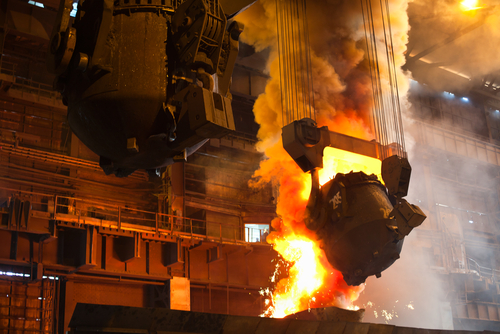Atlas Shrugged, p.33-39
The next character we’re going to meet is Hank Rearden, at work in his steel mills in Pennsylvania. In the name of being fair to Rand, her description of the first pouring of molten Rearden Metal is pretty good:
The narrow streak pouring through space had the pure white color of sunlight. Black coils of steam were boiling upward, streaked with violet red. Fountains of sparks shot in beating spasms, as from broken arteries. The air seemed torn to rags, reflecting a raging flame… But the liquid metal had no aspect of violence. It was a long white curve with the texture of satin and the friendly radiance of a smile. It flowed obediently through a spout of clay, with two brittle borders to restrain it, it fell through twenty feet of space, down into a ladle that held two hundred tons. [p.34]
But, to continue the question I asked last time: How did Dagny know to trust Rearden’s new alloy essentially on sight? I think this section provides the answer to that. Here’s the first description of Rearden; see if you can tell what it is about him that makes him so trustworthy:
The glare cut a moment’s wedge across his eyes, which had the color and quality of pale blue ice – then across the black web of the metal column and the ash-blond strands of his hair – then across the belt of his trenchcoat and the pockets where he held his hands. His body was tall and gaunt; he had always been too tall for those around him. His face was cut by prominent cheekbones and by a few sharp lines; they were not the lines of age, he had always had them; this had made him look old at twenty, and young now, at forty-five. [p.34]
Rand says that Rearden had always been told he was ugly, but it’s pretty clear that this is an informed flaw. Given his icy blue eyes, his blond hair, his height, his prominent cheekbones, and the distinguished lines of his face, it’s obvious that he’s meant to be a handsome fellow.
But Rearden isn’t the only hero whose conspicuous Aryanness is emphasized. Flip back a few pages and see how Rand describes poor, tragic Eddie Willers, who’s on the side of the good guys in spite of what ends up happening to him:
Eddie’s eyes were blue, wide and questioning; he had blond hair and a square face, unremarkable except for that look of scrupulous attentiveness and open, puzzled wonder. [p.15]
And while Dagny isn’t another Nordic heroine, she’s described quite similarly in her first appearance, as I pointed out earlier:
A sweep of brown hair fell back, almost touching the line of her shoulders. Her face was made of angular planes, the shape of her mouth clear-cut, a sensual mouth held closed with inflexible precision. She kept her hands in the coat pockets, her posture taut, as if she resented immobility, and unfeminine, as if she were unconscious of her own body and that it was a woman’s body. [p.20]
Rand, as you can tell, loves to describe her protagonists as if they were roughly chiseled hunks of marble, or people in a Cubist painting – all sharp lines, flat planes and angles. Rereading her description of Dagny, I was reminded of nothing so much as this:
Real women have curves. If you see a woman who is made of sharp-edged polygons, she is probably not real.
— Cliff Pervocracy (@pervocracy) April 5, 2013
But as geometrically unlikely as these descriptions are, we’re clearly meant to treat the heroes’ sharp, angular faces, square jaws, jutting chins, sensual mouths, and determined eyes as markers of their inherent virtue. Now, by contrast, look at Rand’s first description of the bad guy James Taggart:
He had a small, petulant mouth, and thin hair clinging to a bald forehead. His posture had a limp, decentralized sloppiness… a body with an elegance of line intended for the confident poise of an aristocrat, but transformed into the gawkiness of a lout. The flesh of his face was pale and soft. His eyes were pale and veiled… [p.14]
Later in this chapter, we’re going to meet Hank Rearden’s brother Philip, another villain:
Philip had always been in precarious health, though doctors had found no specific defect in his loose, gangling body. [p.39]
And the piece de resistance is Rearden’s wife Lillian, who’s one of the most despicable looters of them all. Rand starts out writing her as if she were gorgeous, but it’s a head fake:
Lillian Rearden was generally regarded as a beautiful woman. She had a tall, graceful body, the kind that looked well in high-waisted gowns of the Empire style… Her exquisite profile belonged to a cameo of the same period: its pure, proud lines and the lustrous, light brown waves of her hair, worn with classical simplicity, suggested an austere, imperial beauty. But when she turned full face, people experienced a small shock of disappointment. Her face was not beautiful. The eyes were the flaw: they were vaguely pale, neither quite gray nor brown, lifelessly empty of expression. [p.39]

You can tell by the squareness of his chin that he’s a brilliant scientist.
So, in contrast to Rand’s angular protagonists, her villains are pale, round, soft, vague, and droopy. And that, I think, is the answer to how Dagny decided to trust Rearden’s alloy. It’s not just the author-on-board phenomenon, it’s that in Randworld, moral worth is linked to physical attractiveness, and heroes and villains can be recognized and distinguished from each other by sight. If someone has steely good looks, you’d do well to buy what they’re selling, and if someone is bald or has a double chin, you’d better run far away!
Of course, Ayn Rand didn’t invent the concept that good and evil people can be sorted based on appearance. It’s a common, if unfortunate, trope in all kinds of media. But the problem, again, is that Atlas is intended to be a philosophy for readers to apply in their real lives. Tolkien didn’t expect anyone to meet elves or orcs on the street. But this book, whether intentionally or not, does send the message that you can judge someone’s character by the steadiness of their gaze and the firmness of their handshake. Needless to say, this isn’t likely to work out as well in the real world as it does in this book.
Other posts in this series:
